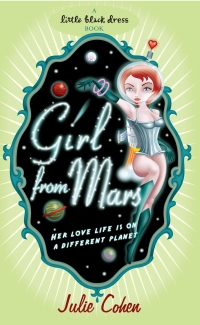Julie Cohen's latest book, Girl From Mars, is about a female comic book artist who takes a vow, in Klingon, not to get a boyfriend. Here she tells us about what she learnt from her research for the book.

I knew, when I decided to write a chick-lit book about a female comic book artist, that I would be venturing into some unknown territory for research. Okay, I’ve always read comics; partly because as a girl, I’ve found it’s been a handy way to make interesting male friends without suffering through sports, but mostly, I just really like reading comics. But also as a girl, I’ve been a little bit intimidated by the whole comics world. All those things in plastic bags, you know? All those artists and inkers and retcons and conventions and the way people in Kevin Smith films talk really, really fast.

Anyway. In the end, I had a blast researching my book. It gave me the excuse to learn about stuff I’ve always wanted to know about, and it meant that I didn’t have to pretend to be cool and know what I was doing, because I was presenting this information to women, chick-lit readers, who may not be big comics readers, too. All I had to do was be accurate and convey my enthusiasm, and hopefully inspire some chick-lit readers to pick up comics. And just maybe, inspire some comics readers to pick up chick-lit, too.
Here are the top five things I learned while doing my research for Girl from Mars:
1. The Stormtroopers. Apparently there are Stormtroopers at every comics convention. I can’t vouch for this personally, but everyone tells me it’s so. If you’re reading this and you’ve been a Stormtrooper at a comics convention: Thank you. That’s the sort of thing that is better than fiction, and that novelists pounce on gratefully.
2. The gutter. The “gutter” is the white bit between comics panels. Scott McCloud, in his book Understanding Comics, taught me that all the action that happens in a comic book actually happens in the reader’s mind, in the blank space between static pictures. This idea is intuitive and fantastically complex at the same time, and it makes my brain twist around thinking about it. It’s a wonderful metaphor for writing fiction, too. Or for looking at how change happens in your own real life: in the spaces between events, when you’re left with nothing but your own mind.
3. 2000AD really is edited by a green man from Betelgeuse called Tharg the Mighty. Really, it is. I went to the offices and they tried to convince me that this guy called Matt Smith was the editor, but I saw Tharg hiding behind the archive shelves, flogging the droids. The yells were horrific.
Get sneak previews, exclusive competitions and details of special events each month!
4. It is not only edited by Tharg, but they have things like original scripts by Alan Moore hanging around in drawers with paper clips, which they will show to fangirl chick-lit writers researching their novels. *Faints*
5. Comic Book Guy doesn’t exist. Without an exception, every single comics professional I contacted to talk about their job was courteous, enthusiastic, and not like the dude in The Simpsons. Many of them are jobbing artists and writers, just like me. I really had nothing to worry about.
Girl From Mars is published by Headline Little Black Dress (£5.99). Julie Cohen's website is www.julie-cohen.com
SFX Magazine is the world's number one sci-fi, fantasy, and horror magazine published by Future PLC. Established in 1995, SFX Magazine prides itself on writing for its fans, welcoming geeks, collectors, and aficionados into its readership for over 25 years. Covering films, TV shows, books, comics, games, merch, and more, SFX Magazine is published every month. If you love it, chances are we do too and you'll find it in SFX.


